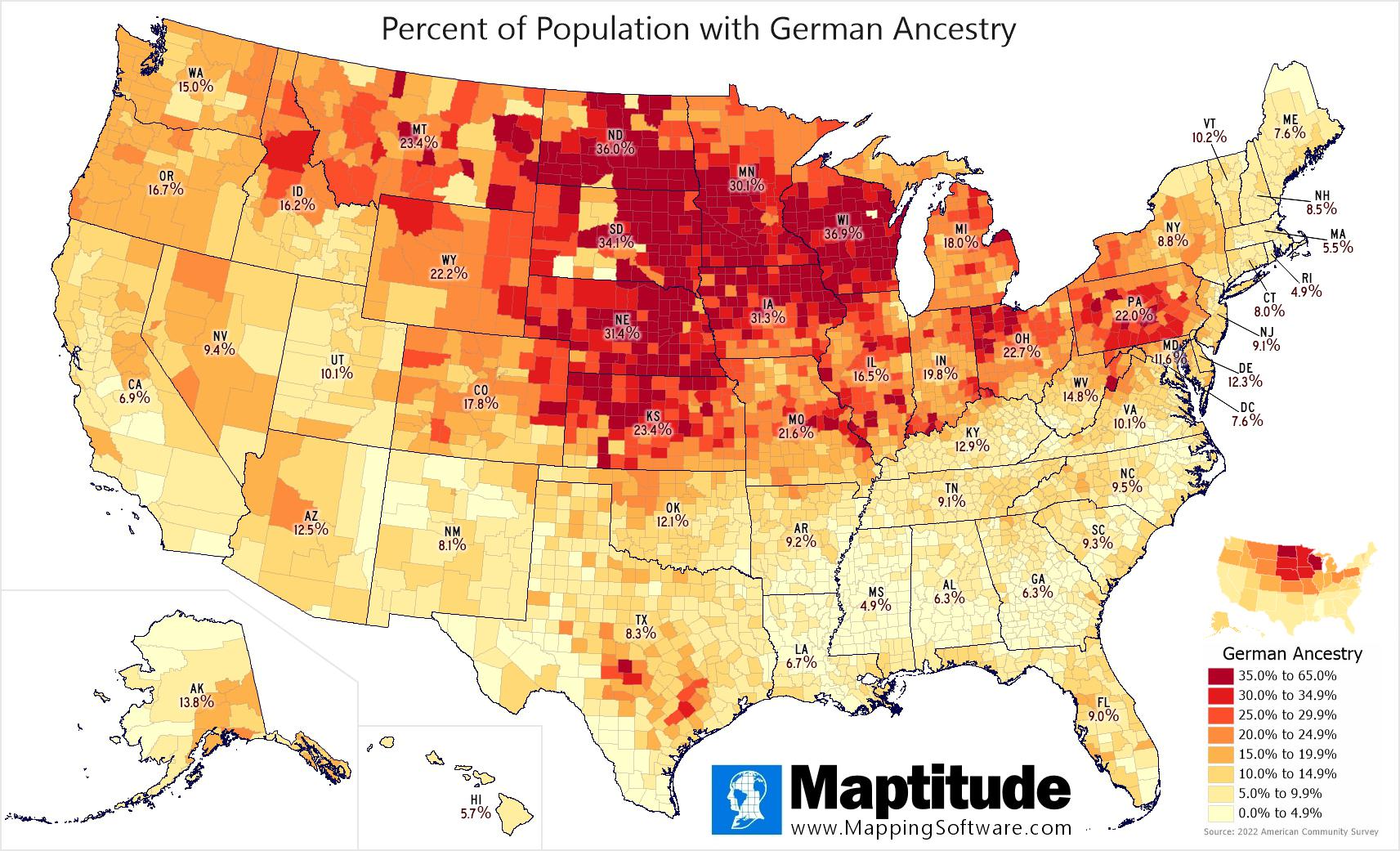German Heritage by U.S. County and State Map


David Chen
Data Visualization Specialist
David Chen is an expert in transforming complex geographic datasets into compelling visual narratives. He combines his background in computer science ...
Geographic Analysis
What This Map Shows
The "German Heritage by U.S. County and State Map" provides a detailed visualization of the distribution of German ancestry across the United States. This map highlights the percentage of individuals with German roots in each state and county, revealing the areas where this heritage is most prominent. With approximately 41.9 million Americans identifying as having German ancestry, which accounts for 12.5% of the population, the map underscores the significant influence of German culture in America.
Deep Dive into German Ancestry in the U.S.
German ancestry in the United States is not just a statistic; it is woven into the very fabric of American life. The large influx of German immigrants in the 19th and early 20th centuries played a crucial role in shaping the nation’s cultural landscape. These immigrants brought their traditions, languages, and customs, which have continued to thrive over generations.
Interestingly, the majority of German-Americans are concentrated in the upper Midwest. States like Wisconsin, North Dakota, and South Dakota exhibit the highest percentages of individuals with German heritage, standing at 36.9%, 36.0%, and 34.1%, respectively. This area was a primary destination for German immigrants, particularly during the mass migrations of the 1800s, when they fled economic hardship and political unrest in their homeland.
Have you noticed that certain counties have remarkably high concentrations of German ancestry? For instance, McIntosh County in North Dakota boasts an astonishing 64.8% of its population identifying as German, while Oliver County follows closely at 64.2%. These figures highlight how certain areas have maintained a strong cultural identity tied to their German roots.
Moreover, the influence of German culture can be observed in various aspects of American life, from cuisine to festivals. Oktoberfest celebrations across the nation, particularly in areas with significant German populations, showcase this heritage. Traditional dishes like bratwurst and sauerkraut have become staples in many Midwestern households, further solidifying the cultural ties that bind these communities.
Regional Analysis
When we break down the map by region, the upper Midwest stands out as the heart of German heritage in the United States. Beyond Wisconsin and North Dakota, South Dakota is another key player, with counties like Campbell County showing 62.5% of its population claiming German ancestry. This concentration is not merely a coincidence; it reflects historical settlement patterns where German immigrants established farms and communities that have persisted through generations.
Interestingly, as we move further east or west, the percentages tend to decrease. In states like California or New York, while there are significant populations of German-Americans, the overall percentage is much lower due to the diverse influx of immigrants from various countries. This variation highlights the unique migration patterns and settlement histories that have shaped different regions of the U.S.
Furthermore, the map indicates that areas with high German ancestry often have vibrant communities that celebrate their heritage. For example, in Wisconsin, the city of Milwaukee hosts one of the largest German festivals in the U.S., attracting thousands who come to celebrate their heritage through music, food, and cultural events.
Significance and Impact
The significance of understanding German heritage in the U.S. extends beyond mere statistics. It reflects the rich tapestry of American identity, showcasing how immigrant cultures have contributed to the nation’s development. As we look towards the future, the impact of this heritage will likely continue to evolve.
Current trends indicate a growing interest in heritage and ancestry among younger generations. Many are taking DNA tests to explore their roots and reconnect with their cultural backgrounds. This renewed interest could lead to a resurgence in the celebration of German heritage and traditions in various parts of the country.
In conclusion, the "German Heritage by U.S. County and State Map" serves as a valuable tool for understanding not just demographics, but the cultural significance of German ancestry in America. It offers a glimpse into how this heritage has shaped communities, influenced traditions, and continues to play an integral role in the broader narrative of American society. As we embrace the diversity of our past, we can better appreciate the contributions of all cultures to the American experience.
Visualization Details
- Published
- October 6, 2025
- Views
- 50
Comments
Loading comments...